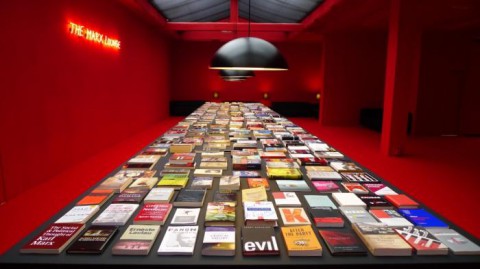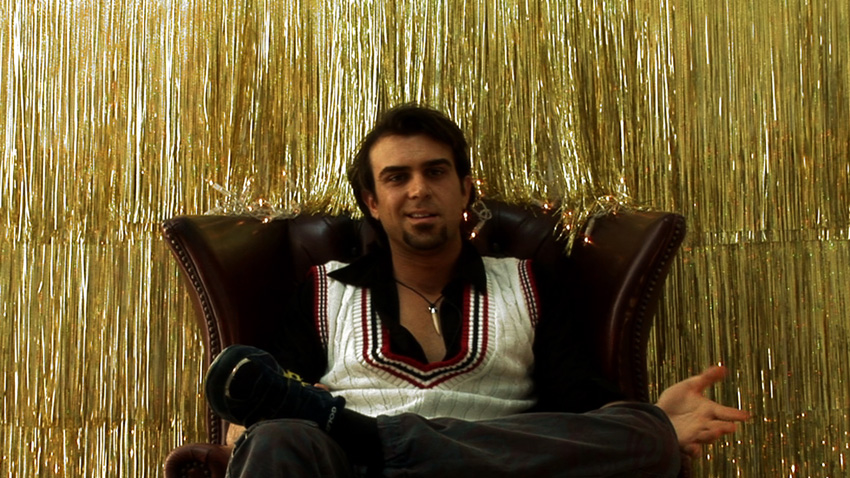
Alfredo Jaar – ‘The Marx Lounge’
Click here to read Andrea Alessi’s interview with Alfredo Jaar, as published on ArtSlant.

Alfredo Jaar – ‘The Marx Lounge’
Click here to read Andrea Alessi’s interview with Alfredo Jaar, as published on ArtSlant.
The Nubuke Foundation’s Kofi Setordji and Odile Tevie visited the Stedelijk Museum Bureau Amsterdam, thanks to the support of the Prins Claus Fund. Stedelijk Museum Bureau Amsterdam is preparing a cultural exchange programme with Ghana, in which Netherlands-based artists and Ghana-based artists will meet and exchange knowledge, skills and experiences. The Nubuke Foundation plays an important role in the production of this Project 1975 exchange programme.
Click here to read more about the Nubuke Foundation and follow this Project 1975 blog to learn more about the cultural exchange programme.
Art critic and curator T.J. Demos wrote the third Project ‘1975’ essay ‘Poverty Pornography, Humanitarianism, and Neo-liberal Globalization: Notes on Some Paradoxes in Contemporary Art’. In reaction to Gerardo Mosquera’s former essay T.J. Demos demonstrates a less optimistic vision on globalization. He criticizes humanitarian aid that only seems to reaffirm unacceptable power structures. He starts by referring to back to Renzo Martens’ Episode III: Enjoy Poverty, a film that generated much critique and initiated SMBA’s current programming.
T.J. Demos states: “…Renzo Martens’ film, Episode III: Enjoy Poverty, set in the Democratic Republic of the Congo (DRC), provides a devastating alternative optic on the brutal nature of North-South relations of inequality and the exploitative image economy that stubbornly mediates it. Despite all its risks – perpetuating stereotypes of Africans as helpless victims, reducing Congolese people to neo-colonized servants and neophytes, reproducing a pornography of poverty – Episode III bears important lessons. Among them, a reality check for optimistic globalists and a lethal blow to the ambitions of concerned documentarians, especially those that seek to ameliorate suffering by representing abjection in developing countries.”
The author furthermore rejects contemporary art practices that focus on political malaise elsewhere and do not consider their own space as a political one, not acknowledging subsequently to be actively participating in a problematic system. Alfredo Jaar’s The Sound of Silence, 2006, is also analyzed by Demos as a critical investigation of the relation between globalization’s image economy and humanitarian photojournalism. In the end Demos explains how Abderrahmane Sissako’s film Bamako (2006) “goes beyond the negative fatalism of media and artistic stereotypes that Okwui Enwezor condemns as ‘Afropessimism’.” Thus the critic sheds light on the many political implications that determine Project 1975. Download SMBA newsletter 121 to read ‘Poverty Pornography, Humanitarianism, and Neo-liberal Globalization: Notes on Some Paradoxes in Contemporary Art’.
T.J Demos is a critic and a Reader in the Department of Art History, University College London, and the co-curator of ‘Uneven Geographies: Art and Globalization’ (Nottingham Contemporary, 2010). Writing widely on modern and contemporary art, he is the author of Migrations: Contemporary Art and the Politics of Globalization (forthcoming, Duke University Press), The Exiles of Marcel Duchamp (MIT Press, 2007), and Technology/Transformation: Wonder Woman (Afterall/MIT Press, 2010).
For ‘The Marx Lounge’ by Alfredo Jaar, the Stedelijk Museum Bureau Amsterdam has been transformed into a reading room with comfortable sofas, reading lamps and a large reading table. The reading table offers a myriad of publications with topics spanning Marxist theory, capitalism, neo-liberalism, post-colonialism, globalization, cultural theory, politics and philosophy. ‘The Marx Lounge’ is a direct response to the financial crisis and to the fundamental questioning of the capitalist system it has elicited. Read more…
Overview of the exhibition ‘Identity bluffs’.
With works by Sara Blokland, Bruno Boudjelal, Mahmoud Khaled, Lucia Nimcova and Nii Obodai.
‘Identity bluffs’ is the second exhibition to take place in the framework of ‘Project 1975’. Bringing together works mostly based on photography and video, the exhibition sheds light on the ways in which migratory processes related to globalisation affect the featured artists’ practices. Read more…

In every newsletter of the exhibitions of Project ’1975′ a guest curator or art critic writes an essay on the topic of post-colonialism in contemporary art. The second one is by Gerardo Mosquera: curator, critic and art historian based in Havana. He is Adjunct Curator at the New Museum of Contemporary Art, New York, and advisor at the Rijksakademie van Beeldende Kunsten, Amsterdam. He is also a member of the advisory board of several art journals. Mosquera co-founded the Havana Biennial in 1984, and has curated many international exhibitions.
Art and Cultural Interactions in a Globalised World
The relationships between contemporary art, culture and internationalisation have been silently yet dramatically transformed in the last fifteen years. We have left behind the times of art trends and manifestos. The key issue for contemporary art today is the tremendous expansion of its international circulation. There are approximately 200 biennials and other periodic artistic events in the world, only to mention one aspect in the growth of art circuits. This explosion involves a vast multiplicity of new cultural and artistic actors circulating internationally and whoe ither did not exist before or were confined to local environments. See Universes-in-Universe just to have an idea of how diverse the international art circuits are today.
The exhibition ‘See Reason’ is the first tentative step of Stedelijk Museum Bureau Amsterdam in a long-term trajectory that will define our programming for the coming period. ‘Project 1975’ raises questions such as: what are the criteria for art in today’s new, geopolitical context? Is such a question even relevant in the postcolonial era? Alternatively, should we speak of a transnational era? Is it even possible to formulate new paradigms, new terminologies for art? Click here to read more about ‘See Reason’.
In every newsletter of the exhibitions of Project ‘1975’ a guest curator or art critic will write an essay on the topic of post-colonialism in contemporary art. The first one to write is Lucrezia Cippitelli, professor of Aesthetics at the Art Academy of L’Aquila, a visiting scholar at Cornell University.
Eurocentrism and its Critique: from Third World Perspectives to Global Internationalism
“Eurocentrism is anti-universalist, since it is not interested in seeking possible general laws of human evolution. But it does present itself as universalist, for it claims that imitation of the Western model by all peoples is the only solution to the challenges of our time.”1 Samir Amin’s incisive analysis of the concept of Eurocentrism traces its origins back to the end of the 1970s. Even if it seems to perfectly depict the world of the early 21st century, this notion first circulated at a time when the global process of decolonization was nearing its conclusion and the postcolonial critique was finding a place in the Anglo-Saxon academic world.2 In his seminal essay published in 1978, the Egyptian Marxist economist uncovers the roots of a phenomenon which he describes as specifically Modern – strongly rooted in the European Renaissance – and built up in only five centuries, in order to justify the powerful and impregnable one-dimensional cultural system of the modern world. The product of this ideological process is, according to Amin, a Western history that shows a progression form ancient Greece to Rome, to feudal Christian Europe, to capitalist Europe.3 It is a cultural construction of a one-dimensional continent (white, Christian, scientifically progressive, in constant philosophical development, enlightened, capitalist, free, democratic), which furthermore over the centuries invented and defended the abstract idea of a dominant West and its counterpart, the Other, the Rest, the Different, and often the Enemy.4
Project ‘1975’ entails a theoretical program in which the disperse notions of post-colonialism in contemporary art are challenged. The kick-off of the theoretical backbone of Project ‘1975’ was a lecture by Paul Goodwin, curator of cross-cultural programmes at the Tate Britain.

The exhibition GEO-graphics. A Map of Art Practices in Africa, Past and Present is the largest part of the Visionary Africa festival in the Bozar Center for Fine Arts in Brussels, held on the occasion of the 50th anniversary of the independence of the Democratic Republic of Congo and 16 other African countries. It is also the first stage in a four-year collaboration between the art center and the Royal Museum of Central Africa in Tervuren, that characteristic museum of colonial museology that will soon be subjected to reconstruction and expansion.
Click here to read the full review ‘The many ambitions of GEO-graphics’ on the website of Nafas Art Magazine.
In a review for Nafas Art Magazine, Jelle Bouwhuis and Kerstin Winking discuss the ninth edition of the Dak’Art Biennial. Unlike the other editions, the exhibition was now divided into an international and a retrospective part. This latter part consisted of works of artists who won the Grand Prix Leopold Sedar Senghor, amongst others Mounir Fatmi (2006), Viyé Diba (1998) and also the late Moustapha Dimé. Because of this retrospective emphasis, the international part of the exhibition was a small presentation of only 27 artists. However, the work of the 2010 Senghor Award, the Congolese-living in France Moridja Kitenge Banza, was memorable, Bouwhuis and Winking argue.
Jelle Bouwhuis discusses Hala Elkoussy’s recent work ‘Myths & Legends Room – The Mural’. The work measures three by nine meters, and deals with the reality of life in Cairo, the city that lies at the base of almost all of Elkoussy’s works. Elkoussy produced a collage-landscape out of photographs from several contexts. Artistically, this large mural therefore exploits the ideas of the photomontage that has become ubiquitous through the advertisement industry. However, for a better understanding of the Mural’s creative background, first reference has to be made to commemorative wall paintings such as those in the National Military Museum in Cairo depicting various war scenes from Egypt’s history, the heroism of the military, and its popular support.
Click here to read the full article on the website of Nafas Art Magazine.